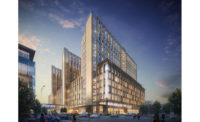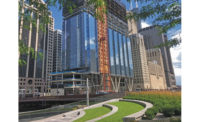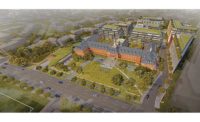Related Link:
ENR Midwest 2023 Top Starts
Continuing high interest rates, the ongoing labor shortage and lagging commercial office construction didn’t keep some contractors in the Midwest from thriving in targeted markets in 2023.
ENR Midwest’s Top Starts list was dominated by categories that are seeing demand for megaprojects: electric vehicle battery production, solar and wind farms, data centers and manufacturing. The cost of work on this year’s list of 33 projects totals over $19 billion.
Clayco’s $750-million project to build a lithium battery manufacturing facility for Entek in Terre Haute, Ind., reflects where the company sees the future going.
“We anticipate continued growth in cloud computing and AI, including data center growth, evolution of EV and related projects throughout the supply chain, growth in renewable energy strategies and continued infrastructure investments,” says Anthony Johnson, president of Clayco’s industrial business unit.
Jeff Blaesing, senior vice president and Kansas City office lead for JE Dunn, agrees that the construction market is currently driven by megaprojects in manufacturing and data centers, but he adds that this work is having downstream effects.

Clayco is building a $750-million lithium battery manufacturing facility in Terre Haute, Ind.
Rendering courtesy of Clayco
“These projects are affecting the labor force and trade partner capacity,” he says. “Construction escalation has returned to pre-pandemic levels, but we don’t expect prices to go down. The market is forecast to remain strong [in Kansas City], but procurement of certain materials and equipment must be procured earlier in the project life cycle to meet schedule requirements.”
Johnson notes that performance in different segments within the construction and real estate industries are polar opposites, which means that Clayco is witnessing “headwinds in traditional developer-led segments, such as multifamily and light industrial, due to elevated interest rates and construction pricing as well as softened demand,” he says.
Johnson doesn’t foresee interest rates decreasing much in the coming year.
“We believe the economy overall is more robust than the Fed anticipated, and as such, rate reductions will be deferred until 2025,” he says.
The upside is that interest rates are more manageable and predictable than in recent years, he says.
“We believe the economy overall is more robust than the Fed anticipated, and as such, rate reductions will be deferred until 2025.”
—Anthony Johnson, President, Industrial Business Unit, Clayco
Like Blaesing, Johnson sees labor shortages and supply chain delays continuing to impact projects.
“Some projects have had slower starts or been delayed, thus pushing out the strain on resources,” he says. “We believe in 2024 and 2025 more of these projects will be ramping up resource needs, thus creating additional regional strains and a national strain. We will continue to see a strain on obtaining electrical equipment with the [increased] demand from data centers and advanced manufacturing projects.”
To mitigate labor challenges, Blaesing says his company is using offsite manufacturing and multitrade prefabrications.
“We take great care in planning of construction schedules with labor analyses and facility in-depth reviews with trade partners to ensure capacity, engagement and support of workforce development programs,” he says.
While projects in urban downtown districts are not generally among the most costly in construction costs on this year’s Top Starts list, there is an exception: The $600-million headquarters for Mutual of Omaha, which is being built by JE Dunn in downtown Omaha, was ranked No. 9 on the list.
Looking forward, Johnson is watching macroeconomic events that could impact 2024 including that it is an election year, which can bring a level of uncertainty to markets; the fact that an enormous amount of commercial real estate debt will come due in the next few years; and the escalation in tensions between China and Taiwan, which could affect global peace, multiple economies and the global semiconductor supply chain.
“Despite these potential events, we remain focused on executing well and delivering our clients’ most significant and complex projects,” Johnson says.






Post a comment to this article
Report Abusive Comment